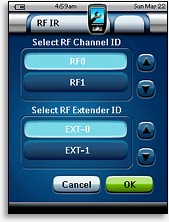|
...Continued from Page 24.
As of the time of this writing there have been four Philips releases and one Marantz release, and Wizz.it 9 is starting to feel like it’s falling behind. Yes, Wizz.it 9 is solid and reliable, however it would be even better with the new features and improvements seen in recent ProntoProEdit NG releases. Of more concern, the RC9500’s firmware has still not been updated to enable all available memory – only 16 megabytes out of the remote’s 48 are usable. Marantz says that major updated firmware and editor versions are on the way and, assuming that all of the improvements seen in the Philips version will be incorporated (and perhaps then some), the RC9500 will once again be able to lay claim as the “high-end” Pronto.
The RC9500 comes with a 73 page bound manual that’s well written with plenty of pictures, diagrams and tips. Limited references are made to the Wizz.it 9 software, which comes with complete built-in help.
Infrared hide and seek.
Not everyone stores their home theater equipment openly beneath their television – many systems have components located in a cabinet, off to the side, behind the main seating area or even in a separate room. If this describes you, then you’ll already know that in those instances infrared-based remotes are essentially useless as light can’t turn corners or go through opaque objects. The TSU7000 and RC9500’s powerful emitters do give the remotes a fair bit of control over exposed off-center equipment in the same room, but for all other circumstances Philips provides the optional $149 RFX6000 radio frequency (RF) extender, available as the RX-77 for $169 from Marantz. The units are identical.

RF Configuration |
The RFX6000 doesn’t add the capability of controlling actual RF equipment, such as many DSS receivers and Bose hifi systems, but instead allows one to control traditional infrared equipment over a radio frequency network. The remote transmits a command to the RFX6000 in radio frequency and then the RFX6000 retransmits it as infrared. The transceiver is a small grey box that measures just 4.4” wide, 3.1” deep and 1.1” thick (11.2cm by 7.9cm by 2.8cm). There’s no external antenna like most competing RF systems – everything’s enclosed.
The RF receiver has four built-in (but less powerful) infrared emitters, two based on front and two on top. It also includes wall or table mounting hardware, so depending on where it’s placed it can broadcast over a fairly large area. The right side of the unit has a DC power-in jack for the bundled wall wart, plus two small dials that adjust its settings – 16 IDs plus 4 channels for operation. A small LED indicates when it has power and flickers when transmitting.
The left side of the extender has four small headphone-style jacks for wired infrared emitters. The unit ships complete with four cables that terminate in dual self-sticking emitters, so ignoring the “wideband” transmitter the extender is capable of controlling 8 devices by wire. It is not possible to specify a particular emitter, but up to 16 individually identified extenders can be added to a single system. RF is configured on the remote or in ProntoEdit NG, individually for each device or system-wide, to either RF or infrared but not both at once.
In some situations it’s possible to operate the RFX6000 from over one hundred feet away, compared to an average maximum infrared distance of 30 feet. However, RF is a picky beast that’s unreliable by nature. Users with thick walls, lots of wiring or a very busy radio spectrum might experience difficulties from just a few feet away from the extender. In my situation the extender functioned well from 50 or 60 feet away (the furthest I could realistically test from), but that’s far from a guarantee that it will work in your particular conditions.
| 
